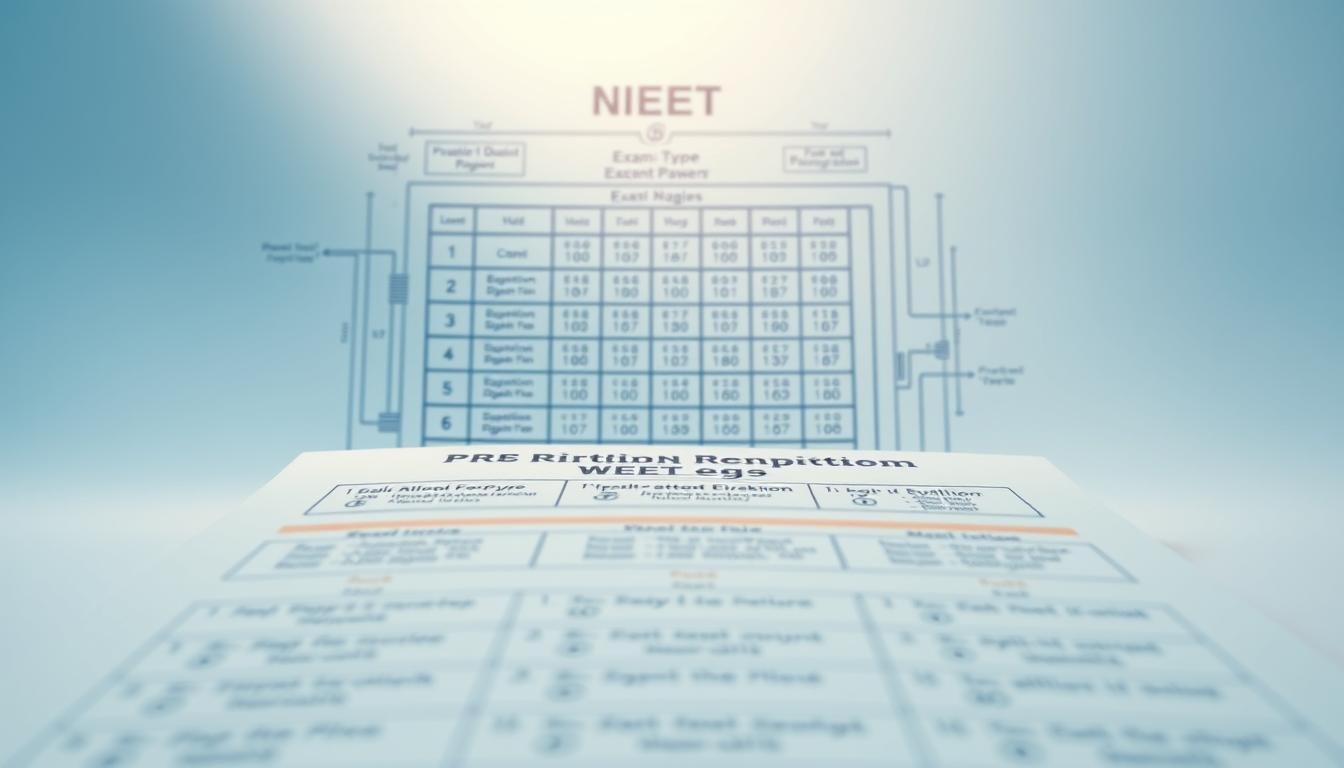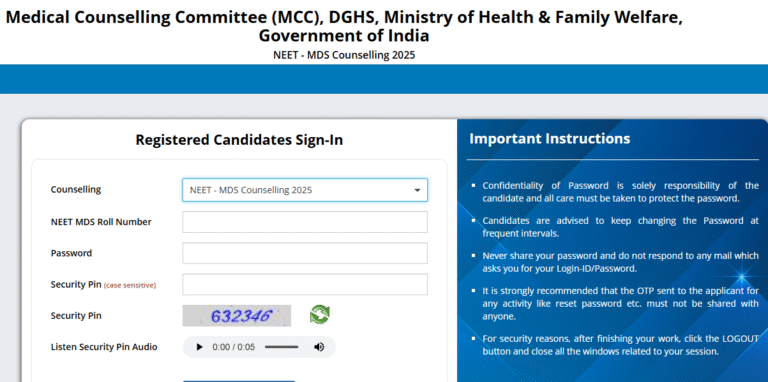Did you know that understanding the scoring system can significantly boost your performance in competitive exams? When it comes to the NEET exam pattern, knowing how marks are allocated can make all the difference.
In this guide, we break down the essentials of the NEET question paper structure. From the total marks to the penalty for wrong answers, we cover it all. This knowledge is crucial for crafting an effective preparation strategy.
Each correct answer awards 4 marks, while incorrect ones deduct 1 mark. Unanswered questions, however, don’t affect your score. With a total of 720 marks up for grabs, every detail matters.
We’re here to help you navigate the exam’s intricacies. By mastering the scoring system, you can focus on maximizing your potential and achieving your goals.
Understanding the NEET Exam Landscape
Grasping the structure of the NEET exam is the first step toward achieving a high score. The exam is designed to test your knowledge across three core subjects: Physics, Chemistry, and Biology. With 180 questions to answer in three hours, time management becomes crucial.
Overview of NEET Exam Structure
The NEET exam consists of 45 questions in Physics, 45 in Chemistry, and 90 in Biology. Each correct answer awards 4 marks, while incorrect ones deduct 1 mark. Unanswered questions do not affect your score. This format ensures a balanced assessment of your understanding across all subjects.
In 2025, the exam will revert to its pre-COVID format, with a three-hour duration and a single-section question paper. This change aims to standardize the process and make it more accessible for candidates across India.
Importance of Exam Pattern Familiarity
Understanding the exam pattern is essential for effective preparation. It helps you allocate time wisely, focus on high-weightage topics, and avoid common mistakes. Familiarity with the pattern also reduces exam-day stress, allowing you to perform at your best.
Post-exam, the answer key and OMR sheets are published for transparency. Analyzing these can help you identify areas for improvement and refine your strategy for future attempts.
Introduction to the neet marking scheme
Mastering the scoring system is key to excelling in competitive exams. The NEET question paper follows a structured approach to evaluate your knowledge. Each correct answer awards 4 marks, while incorrect ones deduct 1 mark. Unanswered questions, however, do not affect your score.
This system is designed to encourage accuracy and discourage guesswork. It ensures that candidates focus on answering questions they are confident about. Understanding this mechanism helps you develop a smarter exam strategy.
- Focus on accuracy over quantity to maximize your score.
- Avoid random guessing to prevent unnecessary deductions.
- Use time wisely to prioritize questions you know well.
Official guidelines emphasize the importance of this system. By adhering to these rules, you can predict your score more accurately. This knowledge is invaluable for refining your preparation and boosting your confidence on exam day.
The Fundamentals of NEET Marking
Scoring high in competitive exams requires a clear understanding of the evaluation process. In the NEET exam, each correct answer awards 4 marks, while incorrect ones deduct 1 mark. This system emphasizes accuracy over guesswork, ensuring candidates focus on their strengths.
Correct Answer and Negative Marking Explained
To maximize your score, it’s crucial to answer questions you’re confident about. Random guessing can lead to unnecessary deductions, impacting your overall performance. Here’s how the marking system works:
- Each correct response adds 4 marks to your total score.
- Incorrect answers result in a deduction of 1 mark.
- Unanswered questions have no effect on your score.
For example, if you answer 150 questions correctly and 10 incorrectly, your score would be calculated as follows: (150 x 4) – (10 x 1) = 590. This formula highlights the importance of accuracy in the exam.
Time management is equally critical. Prioritize questions you know well and revisit uncertain ones if time permits. This approach minimizes errors and maximizes your chances of success.
Detailed NEET Exam Pattern Overview
A clear grasp of the exam’s structure is essential for effective preparation. The NEET exam is designed to test candidates across three core subjects: Physics, Chemistry, and Biology. Understanding the distribution of questions, exam duration, and language options can significantly enhance your performance.
Section-wise Question Distribution
The exam consists of 180 questions, divided into three sections. Physics and Chemistry each have 45 questions, while Biology has 90 questions. Each correct answer awards 4 marks, and incorrect answers deduct 1 mark. Unanswered questions do not affect your score.
Here’s a breakdown of the question distribution:
| Subject | Number of Questions | Total Marks |
|---|---|---|
| Physics | 45 | 180 |
| Chemistry | 45 | 180 |
| Biology | 90 | 360 |
Duration and Languages Offered
The exam duration is 3 hours and 20 minutes. Candidates must manage their time effectively to answer all questions. The exam is available in 13 languages, including English, Hindi, and regional languages. This ensures accessibility for candidates across India.
Understanding these details helps candidates plan their preparation better. It also reduces stress on exam day, allowing them to focus on answering questions confidently.
Subject-Wise Breakdown of NEET Marks
Breaking down the subject-wise allocation can help you strategize better for the exam. Each subject—Physics, Chemistry, and Biology—has a specific weightage that impacts your overall score. Understanding this distribution is the key to optimizing your preparation.
Physics, Chemistry, and Biology Explained
Physics and Chemistry each contribute 180 marks, while Biology holds the highest weightage with 360 marks. Biology is further divided into Botany and Zoology, each accounting for 45 questions. This division ensures a balanced assessment of your knowledge across both subfields.
Here’s a detailed breakdown of the marks allocation:
- Physics: 45 questions, 180 marks
- Chemistry: 45 questions, 180 marks
- Biology: 90 questions (45 Botany, 45 Zoology), 360 marks
Understanding this pattern helps you allocate time effectively. For instance, focusing on Biology can yield higher returns due to its larger mark share. Similarly, balancing your preparation across Physics and Chemistry ensures you don’t miss out on crucial marks.
Tailoring your study plan based on subject weightage is essential. Prioritize topics with higher mark contributions and practice extensively to improve accuracy. This approach not only boosts your score but also builds confidence for the exam day.
How to Interpret the Marking Scheme
Decoding the scoring system can transform your approach to competitive exams. It helps you focus on what truly matters—maximizing your score while minimizing errors. Let’s break down the formula and strategies to achieve this.
Calculation Formula for Scoring
The scoring formula is straightforward yet impactful. Your total score is calculated as follows: NEET Score = (Number of Correct Responses × 4) – (Number of Incorrect Responses × 1). This system rewards accuracy and discourages guesswork.
For example, if you answer 150 questions correctly and 10 incorrectly, your score would be: (150 × 4) – (10 × 1) = 590. This highlights the importance of focusing on questions you’re confident about.
Strategies to Maximize Your Correct Answers
Here are some actionable tips to boost your score:
- Prioritize accuracy: Answer questions you’re sure about first.
- Avoid random guessing: Only attempt uncertain questions if you can eliminate some options.
- Manage time wisely: Allocate more time to high-weightage sections like Biology.
By following these strategies, you can reduce negative marking and improve your overall performance. Understanding the scoring system is a powerful tool to refine your preparation and achieve your goals.
Practical Guidelines for Filling the OMR Sheet
Accurate OMR sheet filling is a critical step in ensuring your exam success. A single mistake can lead to disqualification or loss of marks, impacting your overall performance. We’ve compiled practical tips to help you navigate this process smoothly.
Dos and Don’ts on Answer Marking
Filling the OMR sheet correctly requires attention to detail. Here’s a step-by-step guide to avoid common pitfalls:
- Use only a black or blue ballpoint pen for marking answers.
- Ensure bubbles are fully darkened and free from stray marks.
- Double-check your roll number and test booklet code before submission.
Common mistakes include marking multiple answers, leaving bubbles half-filled, or using incorrect pens. These errors can lead to disqualification or loss of marks.
| Do’s | Don’ts |
|---|---|
| Use a black or blue ballpoint pen | Use pencils or gel pens |
| Darken bubbles completely | Leave bubbles partially filled |
| Verify personal details | Ignore roll number or booklet code |
Practice filling at least 20 sample OMR sheets before the exam. This will help you build speed and accuracy, reducing stress on the actual test day. Remember, every detail matters when it comes to maximizing your score.
Identifying Key Areas for Preparation
Focusing on the right areas can make a significant difference in your exam performance. Understanding the exam pattern and subject-wise weightage is crucial for effective preparation. By analyzing historical trends and past papers, you can identify recurring themes and prioritize topics accordingly.
- Analyze Subject Weightage: Biology holds the highest marks, followed by Physics and Chemistry. Focus on topics with higher contributions to maximize your total score.
- Review Past Papers: Identify frequently asked questions and recurring themes. This helps you understand the exam pattern and prepare strategically.
- Target Weak Areas: Allocate more time to topics you find challenging. Strengthening these areas can significantly improve your overall performance.
Our data-driven approach draws insights from previous years’ trends and current exam patterns. This ensures you focus on the most important topics and avoid wasting time on low-weightage areas. By following these strategies, you can optimize your preparation and approach the exam with confidence.
Utilizing NEET Marking Insights for Exam Strategy
Effective exam strategies start with a deep understanding of the scoring system. By analyzing how marks are awarded and deducted, you can craft a plan that maximizes your performance. This approach ensures you focus on what truly matters—accuracy and efficiency.
Planning Your Time and Question Approach
Time management is crucial for success. With 180 questions to answer in three hours, pacing yourself is essential. Here’s how to allocate your time effectively:
- Prioritize High-Weightage Sections: Biology carries the highest marks, so allocate more time to this section.
- Answer Confidently: Focus on questions you’re sure about to avoid unnecessary deductions.
- Revisit Uncertain Questions: If time permits, return to questions you skipped initially.
Understanding the syllabus is key to identifying high-yield topics. Focus on areas that frequently appear in the exam to maximize your score. This targeted approach reduces wasted effort and boosts your confidence.
Handling high-pressure decisions is another critical skill. Avoid random guessing, as incorrect answers lead to deductions. Instead, use elimination techniques to narrow down options when unsure. This strategy minimizes risks and enhances your overall performance.
By integrating these insights into your preparation, you can approach the exam with clarity and confidence. Remember, a well-planned strategy is your best tool for success.
A Comprehensive Look at Negative Marking
Negative marking is a critical aspect of competitive exams that can significantly impact your final score. It’s designed to encourage accuracy and discourage random guessing, ensuring candidates focus on providing the correct answer. Understanding this system is essential to avoid unnecessary deductions and maximize your performance.
In this section, we’ll explore the rationale behind negative marking, its impact on your score, and practical strategies to minimize its effects. By following these guidelines, you can approach the examination with confidence and precision.
Tactics to Avoid Negative Marking Pitfalls
One of the most common mistakes candidates make is attempting questions they’re unsure about. This often leads to unnecessary deductions. Instead, focus on answering questions you’re confident about first. Here are some tactical tips to help you navigate the scheme effectively:
- Prioritize Accuracy: Only attempt questions where you’re certain of the answer. This minimizes the risk of losing marks.
- Use Elimination Techniques: If you’re unsure, eliminate obviously wrong options to increase your chances of selecting the correct answer.
- Manage Time Wisely: Allocate more time to high-weightage sections and revisit uncertain questions if time permits.
By analyzing previous year data and expert recommendations, we’ve identified these strategies as highly effective. They not only reduce negative marking but also improve your overall score.
It’s also important to know when to take risks and when to exercise caution. For instance, if you can narrow down options to two, it might be worth attempting the question. However, random guessing should always be avoided.
Insights from Previous Year Trends
Analyzing historical data helps candidates set realistic goals and prepare effectively. By understanding past trends, you can identify patterns that reveal what it takes to succeed. This section dives into the cutoffs and benchmarks that candidates must aim for to secure their desired results.
Analyzing Past Cutoffs
Over the years, the cutoffs have shown significant variations. For example, in 2023, the cutoff for the Unreserved category was 275 marks, while it was 245 for SC/ST/OBC candidates. These numbers highlight the importance of understanding the scoring benchmarks for each category.
Here are some key insights from previous years:
- The cutoff marks for the Unreserved category have ranged between 275 and 302 in the last three years.
- SC/ST/OBC candidates must aim for a minimum of 245 marks to qualify.
- Subject-wise performance plays a crucial role in determining the overall score.
By studying these trends, candidates can set realistic goals and focus on areas that need improvement. This analysis also helps in understanding the competition and preparing accordingly.
For instance, candidates must prioritize high-weightage subjects like Biology, which contributes 360 marks. Additionally, regular practice with mock tests can help in achieving the desired score. Historical data shows that consistent preparation and strategic planning are key to success.
Understanding these patterns not only boosts confidence but also ensures that candidates are well-prepared for the challenges ahead. By aligning your preparation with these insights, you can maximize your performance and achieve your goals.
Expert Tips for NEET Exam Success
Choosing the right study materials can make or break your exam preparation. With so many resources available, it’s essential to focus on those that align with the exam pattern neet. We’ve compiled expert advice and a list of recommended books to help you maximize your efforts.
Study Resources and Recommended Books
Selecting the best resources is the first step toward effective preparation. NCERT textbooks are a must for all three subjects—Physics, Chemistry, and Biology. They cover the entire syllabus and are the foundation for many questions in the exam.
Here’s a list of top books recommended by toppers and educators:
| Subject | Recommended Books |
|---|---|
| Physics | Concepts of Physics by H.C. Verma, NCERT Physics |
| Chemistry | Organic Chemistry by Morrison & Boyd, NCERT Chemistry |
| Biology | Biology by Trueman, NCERT Biology |
In addition to these, solving previous years’ question papers is crucial. They help you understand the pattern neet and identify high-weightage topics. Mock tests are equally important for improving time management and reducing exam-day stress.
Here are some actionable tips to enhance your preparation:
- Allocate more time to Biology, as it carries the highest number of marks.
- Focus on NCERT books for conceptual clarity and practice advanced problems from reference books.
- Create a revision schedule that covers all three subjects regularly.
By following these strategies and using the right resources, you can approach the exam with confidence. Remember, consistent effort and smart planning are the keys to success.
Common Mistakes and How We Can Avoid Them
Avoiding common errors can significantly improve your performance in competitive exams. In India, the national testing agency has observed several recurring mistakes that candidates make during the exam. By identifying these pitfalls, we can take proactive steps to avoid them and enhance our scores.
One of the most frequent errors is misinterpreting questions. Many candidates rush through the paper without carefully reading the instructions. This often leads to incorrect answers, even when the knowledge is there. Always take a moment to understand what is being asked before making your choice.
Another common issue is mismanagement of time. With 180 questions to answer in three hours, pacing is crucial. Candidates often spend too much time on difficult questions, leaving insufficient time for easier ones. Prioritize questions you’re confident about and revisit challenging ones later.
Logistical errors, such as incorrect OMR sheet filling, can also cost valuable marks. Ensure that you use the correct pen and darken the bubbles completely. Double-check your roll number and test booklet code to avoid disqualification.
Here are some actionable tips to avoid these mistakes:
- Read Instructions Carefully: Take time to understand each question before answering.
- Manage Time Wisely: Allocate specific time slots for each section and stick to them.
- Practice OMR Sheet Filling: Familiarize yourself with the process to avoid errors on exam day.
By learning from these common errors, you can approach the exam with greater confidence. For those exploring alternatives, consider the option of pursuing MBBS without NEET for Indian students, which offers a different pathway to achieving your medical career goals.
Latest Updates from NEET 2025 and Beyond
The 2025 exam pattern brings significant changes every aspirant should know. These updates, announced by the National Testing Agency, aim to streamline the process and make it more accessible. Understanding these modifications is essential for crafting an effective preparation strategy.
Recent Changes in the Exam Pattern
One of the most notable updates is the removal of Section B optional questions. Previously, candidates could choose 10 out of 15 questions in this section. Now, all 180 questions are mandatory, ensuring a consistent evaluation process.
The exam duration has also been adjusted to three hours, down from three hours and twenty minutes. This change emphasizes time management and requires aspirants to answer questions more efficiently.
Here’s a summary of the key changes:
- Removal of Optional Questions: Section B has been eliminated, making all questions compulsory.
- Updated Exam Duration: The test now lasts three hours, requiring better time allocation.
- Question Type: The introduction of assertion-reasoning questions alongside MCQs adds variety to the exam.
These changes impact the preparation approach. Aspirants must focus on accuracy and speed, as there’s no room for optional questions. The revised weightage of each section remains the same, with Biology holding the highest marks.
By staying informed about these updates, candidates can adapt their strategies and maximize their performance. The key is to practice extensively and manage time effectively during the exam.
Exam Day Do’s and Don’ts
Preparing for exam day involves more than just studying—it’s about mastering the logistics too. Following official guidelines and learning from previous year experiences can help you avoid common pitfalls. Here’s a practical guide to ensure everything runs smoothly.
Start by arriving at the exam center at least 30 minutes before the reporting time. This gives you enough time to complete verification procedures, such as capturing your left thumbprint. Remember, the entry gate closes 30 minutes before the exam starts, so punctuality is key.
Carry only the essentials: your admit card and a valid government-issued photo ID. Prohibited items like electronic devices, jewelry, and writing materials are strictly not allowed. Dress in light-colored clothing without pockets to comply with the dress code.
- Do’s:
- Read all instructions carefully before starting the exam.
- Manage your time effectively, especially during the 3-hour duration.
- Double-check your OMR sheet to ensure accuracy.
- Don’ts:
- Don’t carry any prohibited items to avoid disqualification.
- Avoid random guessing to prevent negative marking.
- Don’t spend too much time on a single question.
Stress management is equally important. Take deep breaths, stay calm, and focus on answering questions you’re confident about. By following these tips, you can handle the exam mode with confidence and precision.
Lastly, learn from previous year experiences. Many candidates have shared that practicing with mock tests and adhering to the guidelines significantly improved their performance. Use these insights to refine your strategy and maximize your score.
Strategies for Post-Exam Analysis & Final Thoughts
Analyzing your performance after the exam is crucial for identifying strengths and areas to improve. By comparing your responses with the official answer key, you can estimate your score and understand where you stand. This step is essential for refining your preparation strategy for future attempts.
To calculate your expected score, use the formula: (Correct Answers × 4) – (Incorrect Answers × 1). This method helps you predict your performance accurately. It also reinforces the importance of accuracy, as discussed throughout this guide.
We recommend creating a table to track your progress. List the questions you answered correctly, incorrectly, and left unattempted. This visual representation makes it easier to analyze patterns and focus on weak areas.
Finally, adopt a reflective approach. Use the insights gained from this analysis to plan your next steps. Regular practice with mock tests and reviewing past papers can significantly improve your performance. By staying consistent and focused, you can achieve your goals.





